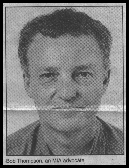By Graydon Royce
Staff Writer
Bob Thompson had been an interested
observer of the POW/MIA
issue for years. But after the suicide
of Dorothy Marian Shelton
in 1990, he felt compelled to do
more. Shelton was married to Air Force Col.
Charles Shelton, who was shot down over
Laos in 1965 and captured. The Pathet Lao
said Shelton died in captivity in 1968 but
Dorothy Shelton went to the jungles of both
Laos and Congress to find out for herself
what happened.
Thompson, a former marine who served in
Vietnam in 1967, has since devoted himself
to the MIA cause. "The reason I dedicated
some of my soul to doing it - and I hate
doing it, it's no fun, I want it to end - is,
that I felt these people need some help, they
just can't take it."
The latest issue for MIA families has been
the discovery of satellite photos that appear
to indicate pilot distress signals. This information,
Thompson charges, is being ignored
or wrongly dismissed as shadows and vegetation by
the Defense Department.
Thompson, 47, who lives in Apple Valley
and is a quality assurance analyst for the
postal service, answered questions last week
about the distress codes and the difficult
road of MIA advocacy.
Q. Are you certain these distress signals,are
recent?
A. These particular ones, GX2527, Serex
and the Wrye signals, there are other signals
that were uncovered in 1989 and 1988, the
USA and the USA K, and one that was hid
den until this year. Yes, I believe they could
not have remained from years ago. I know
from my own experience that the monsoon
in Vietnam is like nothing we see here. The
rain and wind just obliterate everything. Any
signals that would be seen in 1992 would
have to have been recent.
Q. Are these sites locatable? Could we drive
to them? Have they been flown over?
A. Yes, and they've been doing that for the
last two decades.
Q. American planes have?
A. Satellites mainly and maybe planes too,
I'm not exactly sure of that. They have exact
coordinates and grids. The GX2527 was
found directly outside of a known prison
facility near the city of Haiphong.
The SEREX one was found close to that.
Q. Has any private group thought of going
to those places? Hasn't Vietnam opened up
in recent years?
A. The aspect of Vietnam being open is an
interesting one. It's open only as much as
they want it to be open. Our own investigators
that have been over there for years have
never set foot in the prisons that are most
likely, the ones where we have seen the distress signals.
For example the GX2527; We
didn't go to that prison. And of course when
you see the reports come out, you know
they're [The Vietnamese] going to move
these guys. And my belief is that these guys
have been moved many times.
Even through all this, we've never gone to
the prison by Haiphong. They said they were
going to the area and talk to some villagers.
Well, the problem with that is that when you
live in a police state, the slightest infringement
can mean reeducation camp,
which means slave camp, which means death.
So that's one way they keep the story closed.
There have been 17,000 witnesses, 1,700 of
which have been firsthand, live sightings "yes,
I've seen Americans." The Defense Depart
ment discredited and denied every one.
Q. Have any of the sightings or leads ever
produced anything? Has any private organization
ever followed them up?
A. The idea of working on it privately is very
risky. What happened with a lot of the
Southeast Asian intelligence sources was
that they would be identified by our own
government, which would mean at the very
least death for them, if not worse. At least
this is what I believe has occurred. It's really
hard to prove these kinds of things. But if
Americans want to go into Vietnam or Laos
or whatever, they could very easily not come
out again. And the U.S. government could
easily deny that they were aware of this person,
or that this person had any authorization.
You would be very foolish to go
penetrating over there unless you have a suicidal complex.
Q. How would we retrieve these prisoners?
Is Vietnam going to simply admit they have.
them and release them?
A. Many statements, going back to '73, said
that we would have to go back to war with
Vietnam if there were Americans left there
in order to get them back. This, in my mind,
has been a ruse, in that it was never neces
sary to go to war with the Vietnamese.
First of all, one of the biggest finds of the
interim report was the uncovering of the
Nixon-Kissinger letter promising $4.2 billion
in cash and materiel. What the Vietnamese
wanted was reparations. I'm not suggesting
that we pay over the $4.2 billion, but the
reality is that through economic trade and
what not and incentives, that could be done
in that fashion.
|



